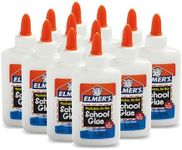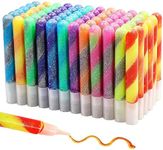Buying Guide for the Best Craft Glues
Choosing the right craft glue can make a significant difference in the quality and durability of your projects. Whether you're working on paper crafts, fabric, wood, or mixed media, understanding the different types of glues and their properties will help you select the best one for your needs. Consider the materials you're working with, the drying time, and the strength of the bond required. Here are some key specifications to consider when picking craft glues.Type of GlueThe type of glue is crucial because different glues are formulated for different materials and purposes. Common types include PVA (white glue), hot glue, super glue (cyanoacrylate), epoxy, and fabric glue. PVA is great for paper and lightweight materials, hot glue works well for quick fixes and heavier materials, super glue is ideal for small, precise bonds, epoxy is perfect for strong, durable bonds, and fabric glue is designed specifically for textiles. Choose the type based on the materials you are working with and the nature of your project.
Drying TimeDrying time refers to how long it takes for the glue to set and become fully effective. This can range from a few seconds to several hours. Fast-drying glues like super glue are great for quick projects and small repairs, while slower-drying glues like PVA allow for adjustments and repositioning before they set. Consider your project timeline and whether you need the flexibility to make adjustments when choosing a glue with the appropriate drying time.
Bond StrengthBond strength indicates how strong the adhesive is once it has dried. This is important for ensuring your project stays intact over time. Glues with high bond strength, such as epoxy and super glue, are ideal for heavy-duty projects and materials that need a strong hold. For lighter materials or temporary projects, a lower bond strength glue like PVA may be sufficient. Assess the durability required for your project to determine the necessary bond strength.
FlexibilityFlexibility refers to how much the glue can bend or move without breaking the bond. This is particularly important for projects involving fabrics or materials that will be handled frequently. Fabric glue and certain types of PVA offer good flexibility, making them suitable for textiles and flexible materials. If your project involves materials that need to remain rigid, flexibility may be less of a concern.
Applicator TypeThe applicator type can affect the ease of use and precision of the glue application. Common applicators include squeeze bottles, brush applicators, glue sticks, and glue guns. Squeeze bottles and brush applicators offer precision for detailed work, glue sticks are convenient for paper crafts, and glue guns provide a continuous flow of glue for larger projects. Consider the size and detail of your project to choose an applicator that will give you the control and convenience you need.
Safety and Non-ToxicitySafety and non-toxicity are important, especially if children are involved or if the project involves items that will be handled frequently. Non-toxic glues like PVA are safe for kids and general use, while some stronger adhesives like super glue and epoxy may require careful handling and ventilation. Always check the safety labels and choose a glue that is appropriate for the users and the environment in which it will be used.













![[5oz Jar] Collectible Gel to Stabilize & Protect Treasured Items - for Home Decor- Clear Removable & Reusable - for a Variety of Surfaces](https://images-proxy.bestreviews.guide/rkggt1CNebGiSwG72SVm_o5QuaE=/0x150/https://m.media-amazon.com/images/I/41SZb6oc0UL._AC_CX679_.jpg)







